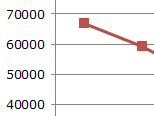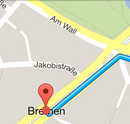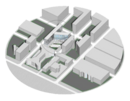The ecological footprint left by the world's leading economic powers is overtaxing the earth as a biotope. Scientific studies have reported a factor of 3.2 for Germany in 2019. This means that Germany is overtaxing the nature 3.2 times more than can be tolerated ecologically. As a consequence, the science is demanding the earlier introduction of measures to regulate environmental protection, and thus counteract climate change.
AMPEG has taken the decision to contribute to the protection of nature and climate.
Do without videos
22 May 2023 Peter Graf
To watch a video, a large amount of data has to be transferred. We should be aware that this transfer does not take place somewhere in the clouds, but requires a lot of IT resources.
Even if in the meantime the enormous electricity consumption for the operation of the servers and the cooling of the data centre comes from renewable energies for some operators, we are still missing it elsewhere because green energy is still far too scarce a commodity.
We should rather use green energy from wind and sun for the production of hydrogen or the operation of electric drives than for excessive entertainment and information transfer with videos.
AMPEG therefore closed its video channel more than 10 years ago and refrains from placing videos on its website since then.
![[Translate to Englisch:] Klimamoor](/fileadmin/_processed_/a/9/csm_huehnermoor-hochmoorlandschaft_20b62f5e3f.jpg)
In order to neutralise our remaining CO2 emissions, AMPEG has acquired climate certificates for ten years.
After intensive consultation, we decided against this program.
![[Translate to Englisch:] Flugreisen](/fileadmin/_processed_/6/6/csm_flugreisen_2d442b6ce6.png)
The first calculation of our ecological footprint for 2009 scared us off: About 5 tons of CO2 for an employee's flight to San Diego, California, for training.
We were not aware of the fact that it is so much until then.

Since 2009, certificates have been offset for AMPEG every year to neutralise the company’s carbon footprint. With these offsetting certificates, which currently cost €9.90 per tonne of CO2e, various projects are supported onsite.
On the recommendation of the agency with which we published the emissions report, support has been provided to the following projects:
- The Yuntdag wind park project, Turkey
- The Mamak landfill gas project, Turkey
- From 2014, the Wildlife Works Kasigau Corridor project, Kenya
The Wildlife Works Kasigau Corridor in Kenya is a REDD (Reducing Emissions from Deforestation and Forest Degradation) project, which aims to protect some 170,000 hectares of dry forest and savannah. The project area is home to countless endangered species of animals, and links Tsavo East and Tsavo West national parks, which stretch from southeast Kenya to the border with Tanzania.

Virtualising our servers in 2008 and 2009 was the most important of the many steps we took to reduce AMPEG’s electricity consumption.
In late 2013, just before AMPEG moved, we took further steps.

Make your daily commute to work your workout: Driving to work in the morning, trying to keep your cool in rush hour traffic on the way home after a long day at the office, and then getting in a round of exercise on the cross trainer or going out for a run… If that routine sounds all too familiar, the tips below might be just what the doctor ordered.

The many enquiries we have received show that other companies are also interested in how to calculate the carbon emissions of internet data transfer.
Below is a description of the method for calculating emissions due to internet data transfer, which AMPEG commissioned another company to develop especially for its carbon neutrality project.

In the past months, we have focused on gearing our company’s environmental protection measures to achieving the target of becoming carbon neutral. Following the decision to launch this project in early 2010, we were eager to find out whether a service provider and software vendor like AMPEG could afford to achieve carbon neutral certification.

In order to substantiate the importance of the topic of environmental protection at the company, in January 2010, AMPEG adopted it in the employment contracts for all salaried employees in line with the following paragraphs.
By doing so the company’s singular attitude to environmentally-friendly behaviour is designed to encourage individual employees to act.

Old versus new – We did the test and a lot has changed in the last few years
One thing up front: since we started buying more powerful PCs, things have really started to happen with the electricity they consume under load.

An example of business stationery taken from our practical experience.
Lots of employees at large and small companies have told us they don’t print on both sides of the paper, because its too complicated and the settings often don’t work. While it is true that a series of valuable yet highly complex technical options do exist for printing on both sides, it also possible to use the following method that we setup easily on our printer.

Technical advantages dominate communication with the customer: Advertising brochures, catalogues, online promotions, spots and similar etc. seduce us into buying electronic appliances all the time that later prove to be needless energy guzzlers. So who is responsible for this: the customer or the marketing departments at the companies selling the products?

The fourth time we moved office, we took location factors that reduce the burden on the environment into account.
“If you don’t get it right the second time, you’re bound to get it right the third” is a saying that many of you will be familiar with. On moving offices for the third time we should also have managed to take factors that reduce the burden on the environment into account when choosing the location.

How to setup a central power management policy for Windows: A policy setup in the Windows network Active Directory (group policy) manages centrally the power options in Windows Vista and Windows 7.

Any company can optimize its energy balance with a few simple measures. Virtualizing our server has had one of the greatest effects here.
Trimming a company for energy efficiency is no work of magic. "If a project of this nature is to be considered under the aspect of climate protection, then you need a massive dollop of idealism", says Peter Graf, Chief Executive Officer at AMPEG. "But the results are there for the taking: compared to 2007, we use 30 percent less electricity a year now." AMPEG succeeded in making the most significant savings by virtualizing its server.

No business can do without commercial stationery such as letterheads, business cards and advertising material. So what steps can you take to reduce the burden on the environment when it comes to printed matter?
The new design of our letterhead and product data sheets provided us with lots of opportunities to make savings.
Climate neutralisation
Since 2009 until today AMPEG is a climate neutralised company. This was all made possible by the reduction measures performed by AMPEG from 2003 onwards. These measures have also ensured that the AMPEG product Security Lighthouse could be developed, supported and sold on an climate neutral basis.
